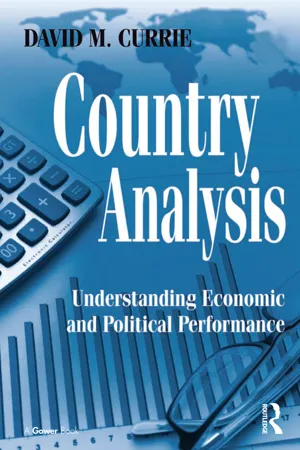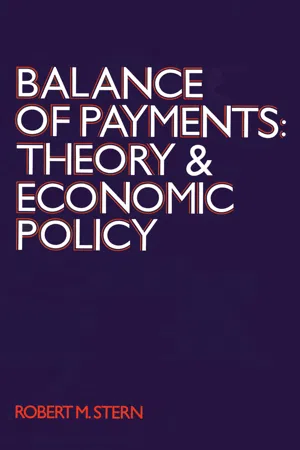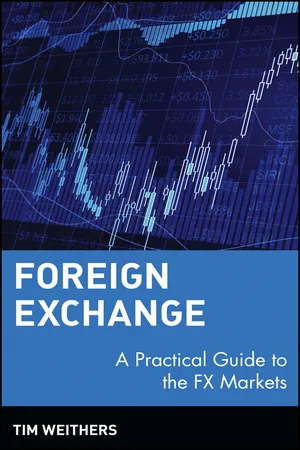Changes in Exchange Rate
Changes in exchange rate refer to the fluctuations in the value of one currency relative to another. These changes can impact international trade, investment, and the overall economy of a country. Exchange rate movements are influenced by various factors such as interest rates, inflation, geopolitical events, and market speculation.
7 Key excerpts on "Changes in Exchange Rate"
- eBook - ePub
Country Analysis
Understanding Economic and Political Performance
- David M. Currie(Author)
- 2016(Publication Date)
- Routledge(Publisher)
...82; Alistair MacDonald, “European firms tackle dollar problem”, Wall Street Journal, Dec 11, 2007, p. A12. Another explanation for the failure of macroeconomic models concerns causality. It isn’t obvious that macroeconomic fundamentals cause Changes in Exchange Rates. It is possible that fluctuations in exchange rates cause changes in macroeconomic fundamentals. For example, in formula (9) showing the principle of interest rate parity, economists traditionally have posited that changes in interest rates affect the forward rate for a currency pair. But it is possible that causality goes the other way: changes in the forward rate cause changes in interest rates. One thing economists have found out is that models based on macroeconomic fundamentals are better at predicting exchange rates in the long run than in the short run, where the long run is 12 quarters (three years) or more. Unfortunately, many business decisions incorporating exchange rates are made in the short run (one or two quarters), where macroeconomic fundamentals aren’t as effective at predicting exchange rates. In summary, it’s not possible to predict exchange rates, although many late-night infomercials try to get your money based on their ability to predict. It’s also a great field for academic research, particularly if you’re into mathematics. Conclusion An exchange rate is the price of one currency in terms of another currency. When the government sets an exchange rate, it is called a pegged currency regime. When the market determines an exchange rate, it is called a floating currency regime. Exchange rates fluctuate constantly, depending on market participants’ views about economic and political conditions, as well as market psychology. When a currency appreciates, it increases in value on the currency market; when a currency depreciates, it decreases in value...
- eBook - ePub
- W. Charles Sawyer, Richard L. Sprinkle(Authors)
- 2020(Publication Date)
- Routledge(Publisher)
...CHAPTER 14 Exchange rates and their determination A basic model The exchange rate is determined from day to day by supply and demand of home currency in terms of foreign currency. Each transaction is two-sided, and sales are equal to purchases. Any change in the conditions of demand or of supply reflects itself in a change in the exchange rate, and at the ruling rate the balance of payments balances from day to day, or from moment to moment. Joan Robinson INTRODUCTION T he international value of a country’s currency has become an inescapable part of the daily flow of economic information. Most of us are aware that a country’s exchange rate is important, but many of us do not have a clear idea of why the exchange rate matters or what causes it to change. As the chapter’s opening quote indicates, the familiar tools of supply and demand analysis can be used to determine a country’s exchange rate. In this chapter, you will learn why the supply and demand model works in analyzing exchange rates—in the same manner, in fact, that it works in analyzing the price of gasoline or pizza, for one dollar or one yen or one gallon of gasoline is indistinguishable from another. By the end of this chapter you should have a good grasp of why exchange rates are important and what factors cause them to change over the long run. Finally, it is obvious to even a casual observer that exchange rates change frequently. These changes, or volatility, are a source of aggravation for individuals, businesses, and governments. The chapter explains what economists know about the effects of exchange rate volatility on international trade and how Changes in Exchange Rates affect the prices of the goods and services we purchase. The final part of the chapter deals with the underlying value of a currency. While the exchange rate we observe in the market often differs from that value, it is very useful to know what that value is. EXCHANGE RATES Suppose that a U.S. importer is purchasing British Jaguars...
- eBook - ePub
Development Economics
Theory and Practice
- Alain de Janvry, Elisabeth Sadoulet(Authors)
- 2021(Publication Date)
- Routledge(Publisher)
...Countries like the US can run large deficits in their balance of current accounts (imports and exports) only because they have compensating large surpluses in their balance of financial accounts (financial-asset flows). Others like China do just the opposite, running large surpluses in their balance of current accounts which are absorbed by large deficits in their balance of financial accounts. Demand for currency-conversion services now totals billions of dollars a day in the spot market and trillions in the foreign exchange derivatives markets. The scale of these activities means that macroeconomic policy, in developed and developing countries alike, must include consideration of international financial flows. As we will see later in the chapter, the exchange rate is also affected by trade policies. The value of the currency is ultimately determined by a combination of market forces and government, both central bank and trade interventions. The exchange rate is also regarded as the value of one country’s currency in relation to another currency. When the nominal exchange rate e declines in currency markets due to a change in the balance between supply and demand of dollars (with supply increasing more than demand), this is termed appreciation of the domestic currency relative to the foreign currency. The terminology may be a bit confusing, but it makes sense. When the exchange rate decreases, the local currency—say, the Mexican peso—gains value as Mexicans need fewer LCUs to buy a dollar. Conversely, the nominal exchange rate e can rise, in which case the domestic currency depreciates. These movements are heuristically represented in Figure 9.1. Figure 9.1 Movements of the nominal exchange rate Exchange Rate Regimes From a purely financial perspective, the nominal exchange rate is an important policy variable as it is the price at which currencies are transacted...
- eBook - ePub
- Enrico Colombatto(Author)
- 2016(Publication Date)
- Routledge(Publisher)
...For example between mid-October 2014 and mid-March 2015, the €/$ exchange rate moved from 0.78 (euro per dollar) to 0.95 – a 21.8 per cent rise. At first sight, exchange-rate movements are relatively easy to explain. Since the exchange rate is defined by the demand/supply of a given currency, the main variables at play are those that affect money demand and money supply. For example, suppose that the central bank of country A issues large amounts of paper money (dollars), and that the residents of A use at least part of these new dollars in order to buy foreign goods and services (imports). Let us also assume that imports are paid in currency B (yen). Importers, therefore, will necessarily sell dollars and buy yen. Ceteris paribus, when the new dollars make their way to the currency market (the supply of dollars increases), the dollar will depreciate (weaken). This is illustrated in Figure 9.2, in which the vertical axis measures the exchange rate of the dollar (yen per dollar), and the horizontal axis indicates the amount of dollars exchanged. The figure shows that the initial value of the exchange rate S is 104 yen per dollar (see the continuous lines), while after the newly printed dollars have reached the foreign-exchange market, the supply of dollars shifts to right (see the dashed line) and the exchange rate moves to 95 yen per dollar. Figure 9.2 The exchange rate and the money supply An example concerning the demand side is offered in Figure 9.3, which depicts a situation in which producers in country A post greater increases in productivity than their competitors in B. If the cost of inputs in country A stays constant, the rise in productivity will initially make A's goods relatively cheaper. A's buyers will thus turn to their domestic producers and B's buyers will try to import more from A. As a consequence, the demand for currency A (dollars) on the exchange-rate market increases, and its supply will decrease (see the dashed lines)...
- eBook - ePub
- James P. Neelankavil, Anoop Rai(Authors)
- 2014(Publication Date)
- Routledge(Publisher)
...The most liquid currencies in the world are the U.S. dollar and the euro. For a truly free floating exchange rate regime, where prices are determined solely by demand and supply, it is necessary for foreign exchange markets to operate without government intervention or institutional restrictions. Such markets do not exist today, because most countries impose some form of restriction on the transfer of foreign currencies. In the United States, it is not possible for individuals to open foreign currency accounts overseas or write checks in foreign currencies. Countries that earn a limited amount of foreign currency through exports are usually the ones that impose the most restrictions. This allows them to allocate the scarce foreign exchange to industries of economic importance. For example, a small country earning scarce foreign exchange through the sale of one commodity may allow the imports of capital goods but ban the imports of luxury goods. Such barriers to the free movement of foreign currencies distort currencies ‘ true market prices. As a result, forecasting exchange rates is complicated and requires abroad understanding of the market environment in which foreign exchange is traded. The following factors play a major role in the determination of foreign exchange rates for all countries. I NFLATION R ATES The difference in inflation rates between two countries affects the foreign exchange rates between two countries. The country with the higher inflation rate will experience a depreciation of its currency relative to the other country, a phenomenon termed “purchasing power parity.” I NTEREST R ATES Since interest rates and inflation rates go hand in hand, the relationship is similar to that of inflation rates. Ceteris paribus, the country with the higher interest rate should see its currency depreciate relative to the other country. E XPORTS AND I MPORTS If a country is successful at exporting, it has the ability to earn more foreign exchange...
- eBook - ePub
Balance of Payments
Theory and Economic Policy
- Robert Stern(Author)
- 2017(Publication Date)
- Routledge(Publisher)
...Given the desire to pursue independent national goals, it would appear that some type of system of exchange-rate variability will in fact be required. Thus, if one country decides for domestic purposes to adopt a low or high rate of interest relative to other nations, and capital is less than perfectly mobile internationally, it can do so without undue concern for external balance since its exchange rate can be relied upon to vary automatically to help achieve this end. This presumes, of course, that individual nations do not wantonly expose themselves to deliberate inflation or deflation domestically and that they do not seek to improve their economic position at the expense of other nations. If neither of these presumptions is valid in actuality, then it may not be surprising, under the circumstances, if a system of freely fluctuating exchange rates gives the appearance of being ineffective. What is important to realize in such instances, however, is that the source of the difficulty lies in the nature of the policies being followed rather than in the system per se of freely fluctuating exchange rates. The efficacy of freely fluctuating exchange rates can be said to depend fundamentally, therefore, upon the successful implementation of monetary and fiscal policies for domestic stabilization purposes. Assuming that the objectives of policy are sustained full employment, with stable domestic prices, it is important to inquire about the degree to which exchange rates may in fact fluctuate and the theoretical conditions that must prevail in order for the foreign exchange market to be stable. Both of these points can be dealt with, as we already have seen, in terms of the relative elasticities of demand and supply schedules of foreign exchange and of the underlying demand and supply schedules of imports and exports of goods and services...
- eBook - ePub
Foreign Exchange
A Practical Guide to the FX Markets
- Tim Weithers(Author)
- 2011(Publication Date)
- Wiley(Publisher)
...Commercial banks are sometimes asked to assist their local clients with their foreign exchange risk. Investment banks tend to be more active, but this depends on the reason for their FX trading (facilitating client transactions, hedging their business exposures, cross-border issuance, international mergers and acquisitions, and even proprietary trading). Central bank activity ranges from the management of their foreign reserves through active FX market intervention. Of course, if exchange rates never moved (i.e., if they were fixed), then much of the trading activity (whether hedging or implementing views on the market) would cease. Having spelled out the economic rationale for many of the trades undertaken by the FX market participants, we now consider the possible implications of fixed exchange rates. FIXED VERSUS FLOATING EXCHANGE RATES Economists have long debated the advantages, disadvantages, virtues, shortcomings, merits, costs, and benefits of a fixed exchange rate system versus a floating exchange rate system. “Does the choice of exchange rate regime matter? Few questions in international economics have sparked as much debate and yielded as little consensus.” 6 Fixed Exchange Rates The attraction of fixed exchange rates is the presumed stability they provide for those engaging in international transactions. If USD|JPY is fixed at 120.00, then a U.S. software firm can enter into trade agreements in which their product will sell for JPY 6,000 in Japan—comfortable that they will receive USD 50 as a result of that sale. Similarly, a Japanese automobile manufacturer might sleep better knowing that their cars, selling in the United States for USD 20,000, will appear on the bottom line as JPY 2,400,000. Sounds good. The real problem, though, with fixed exchange rates is that someone must keep them fixed...






